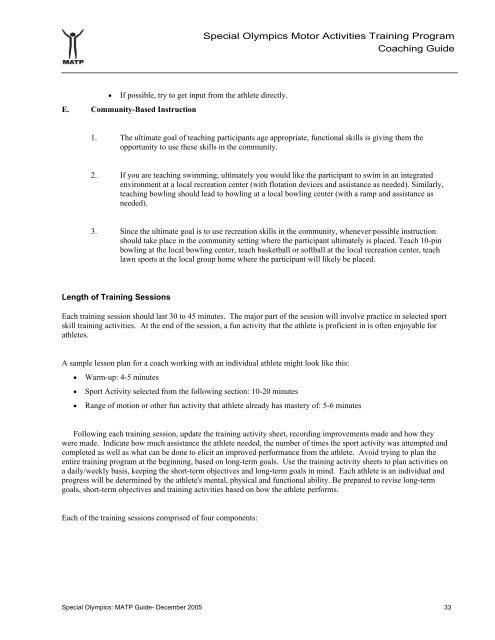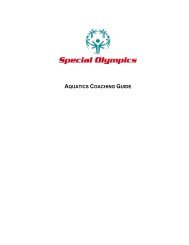MATP Coaching Guide - Special Olympics
MATP Coaching Guide - Special Olympics
MATP Coaching Guide - Special Olympics
You also want an ePaper? Increase the reach of your titles
YUMPU automatically turns print PDFs into web optimized ePapers that Google loves.
<strong>Special</strong> <strong>Olympics</strong> Motor Activities Training Program<br />
<strong>Coaching</strong> <strong>Guide</strong><br />
If possible, try to get input from the athlete directly.<br />
E. Community-Based Instruction<br />
1. The ultimate goal of teaching participants age appropriate, functional skills is giving them the<br />
opportunity to use these skills in the community.<br />
2. If you are teaching swimming, ultimately you would like the participant to swim in an integrated<br />
environment at a local recreation center (with flotation devices and assistance as needed). Similarly,<br />
teaching bowling should lead to bowling at a local bowling center (with a ramp and assistance as<br />
needed).<br />
3. Since the ultimate goal is to use recreation skills in the community, whenever possible instruction<br />
should take place in the community setting where the participant ultimately is placed. Teach 10-pin<br />
bowling at the local bowling center, teach basketball or softball at the local recreation center, teach<br />
lawn sports at the local group home where the participant will likely be placed.<br />
Length of Training Sessions<br />
Each training session should last 30 to 45 minutes. The major part of the session will involve practice in selected sport<br />
skill training activities. At the end of the session, a fun activity that the athlete is proficient in is often enjoyable for<br />
athletes.<br />
A sample lesson plan for a coach working with an individual athlete might look like this:<br />
Warm-up: 4-5 minutes<br />
Sport Activity selected from the following section: 10-20 minutes<br />
Range of motion or other fun activity that athlete already has mastery of: 5-6 minutes<br />
Following each training session, update the training activity sheet, recording improvements made and how they<br />
were made. Indicate how much assistance the athlete needed, the number of times the sport activity was attempted and<br />
completed as well as what can be done to elicit an improved performance from the athlete. Avoid trying to plan the<br />
entire training program at the beginning, based on long-term goals. Use the training activity sheets to plan activities on<br />
a daily/weekly basis, keeping the short-term objectives and long-term goals in mind. Each athlete is an individual and<br />
progress will be determined by the athlete's mental, physical and functional ability. Be prepared to revise long-term<br />
goals, short-term objectives and training activities based on how the athlete performs.<br />
Each of the training sessions comprised of four components:<br />
<strong>Special</strong> <strong>Olympics</strong>: <strong>MATP</strong> <strong>Guide</strong>- December 2005 33
















